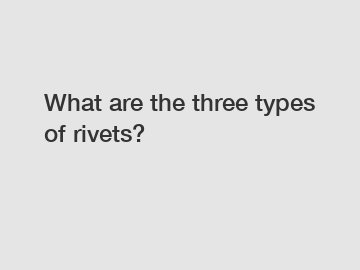What are the three types of rivets?
What are the three types of rivets?
Rivets are mechanical fasteners used to join materials together permanently. They are widely used in industries such as aerospace, automotive, construction, and manufacturing. Rivets are designed to provide secure and reliable connections, even in high-stress applications. In this article, we will explore the three common types of rivets and their key characteristics.
Solid Rivets:

Solid rivets are the oldest and simplest type of rivets. They consist of a cylindrical shaft with a head on one end and a tail on the other. Solid rivets are installed by inserting them into pre-drilled holes and then deforming the tail end to create a mechanical lock. This deformation, typically achieved by using specialized tools such as a riveting hammer or a pneumatic rivet gun, causes the rivet to expand and fill the hole, creating a strong and secure connection. Solid rivets are known for their excellent shear and tensile strength, making them suitable for heavy-duty applications. They can withstand high temperatures and provide good resistance to corrosion. Industries that commonly use solid rivets include shipbuilding, structural engineering, and railway construction.
The Advantages of Solid Rivets:
- High strength and reliability.
- Excellent resistance to temperature and corrosion.
- Long-lasting and durable.
The Disadvantages of Solid Rivets:
- Requires pre-drilled holes for installation.
- Difficult to remove or replace without damaging the connected materials.
Blind Rivets:
Blind rivets, also known as pop rivets, are widely used for applications where the backside of the joint is inaccessible. They consist of a hollow body and a mandrel, which is a thin metal rod inserted into the hollow body during installation. Blind rivets are installed by inserting them into the pre-drilled hole, then pulling the mandrel using a specialized tool, causing the rivet to deform and create a bulge on the blind side of the joint. This bulge secures the materials together. The mandrel is then snapped off, leaving only the formed rivet body. Blind rivets are user-friendly and require minimal skill for installation, making them popular for applications in automotive assembly, electrical enclosures, and household appliances.
The Advantages of Blind Rivets:
- Easy and quick installation.
- Suitable for confined spaces or inaccessible joints.
- Wide range of sizes and materials available.
The Disadvantages of Blind Rivets:
- Lower strength compared to solid rivets.
- Limited grip range, which may restrict their use in certain applications.
Structural Rivets:
Structural rivets, also known as high-strength blind rivets, are designed to offer superior strength and load-carrying capacity. They are commonly used in industries where high-stress applications require a more robust fastening solution. Structural rivets have a solid body and a mandrel, similar to blind rivets. However, they feature a larger diameter and a longer grip range, providing enhanced strength and more extensive material compatibility. Structural rivets are used in a wide range of applications, including heavy machinery, bridges, aircraft, and infrastructure projects.
The Advantages of Structural Rivets:
- High-strength rating.
- Suitable for heavy-duty and high-stress applications.
- Large grip range for compatibility with various materials and thicknesses.
The Disadvantages of Structural Rivets:
- More expensive compared to solid and blind rivets.
- Requires a higher level of expertise for installation.
Conclusion:
In summary, the three common types of rivets include solid rivets, blind rivets, and structural rivets, each with its own unique advantages and disadvantages. Solid rivets offer high strength and reliability but require pre-drilled holes for installation. Blind rivets are user-friendly and suitable for inaccessible joints but have lower strength compared to solid rivets. Structural rivets provide excellent load-carrying capacity and are commonly used in heavy-duty applications but are more expensive and require expertise for installation. If you have any further questions or need assistance in selecting the right rivets for your specific application, please do not hesitate to contact us.
Are you interested in learning more about Automatic Riveting Machine, auto screwing machine whith feeding system, offline Selective Soldering Machine? Contact us today to secure an expert consultation!
205
0
0

Comments
All Comments (0)